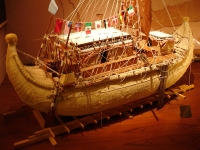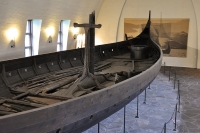Things to do in Oslo
Oslo is probably most famous for being hemmed in by its main attractions, the natural glory of the fjord and stretching woodlands that offer so many scenic spots and outdoor activities for the fit and adventurous.
However, it is also an artistic, cosmopolitan city that offers numerous cultural and historical sightseeing opportunities. Many of Oslo's best cultural attractions can be found on the Bygdoy Peninsula, including the incredible Viking Ships Museum, the Kon-Tiki Museum, and the Fram Polar Ship Museum, leaving travellers in no doubt as to the seafaring and explorative laurels of Norway.
The Oscarshall Castle, Bygdoy Royal Estate, and Norwegian Museum of Cultural History can also be found on the picturesque peninsula. Other must-see attractions in Oslo include the National Gallery, which houses Edvard Munch's iconic painting 'The Scream', and Vigeland Park, which is the city's most visited tourist attraction.
The Oslo Pass gives visitors free access to more than 30 museums and sightseeing attractions and free travel on all public transport as well as many other perks. The card comes in versions valid for 24, 48, or 72 hours, and is great value for money. The pass can be bought at tourist information centres and many hotels, hostels, and museums, or can be ordered online.

Vigeland Park
Vigeland Museum and Park is Oslo's most visited attraction, and one of the most popular tourist attractions in Norway. It is a vast green area of duck ponds, trees, and lawns that …
Vigeland Park
Vigeland Museum and Park is Oslo's most visited attraction, and one of the most popular tourist attractions in Norway. It is a vast green area of duck ponds, trees, and lawns that is a monument to the celebrated Norwegian sculptor Gustav Vigeland. He spent 40 years creating the life-size statues that decorate the walkways and open spaces.
There are more than 200 works presenting the human form in a variety of poses and conveying a range of emotions. At the centre of the park is the most impressive piece, the Monolith, a gigantic mass of writhing bodies carved from a single column of stone and believed to be one of the largest granite sculptures in the world at a height of 46ft (14m).
Surrounding the column are groups of human sculptures in various forms of interaction with each other. The most famous and most photographed piece is the Angry Boy, a fat child stamping his foot. There are many more sculptures to be seen in the park and in the nearby Vigeland Museum, featuring a display on the development of the artist's work and his sketches and plaster originals.
Visitors should note that although the attraction is commonly called Vigeland Park, the collection of sculptures is technically in a middle section of Frogner Park. Guided tours are available for the museum.
Website www.vigeland.museum.no/en

The Kon-Tiki Museum
Situated on the Bygdoy Peninsula, the Kon-Tiki Museum contains the iconic balsawood raft, the Kon-Tiki, on which Thor Heyerdahl made his famous journey across the Pacific in 1947 t…
The Kon-Tiki Museum
Situated on the Bygdoy Peninsula, the Kon-Tiki Museum contains the iconic balsawood raft, the Kon-Tiki, on which Thor Heyerdahl made his famous journey across the Pacific in 1947 to prove the theory that the first Polynesian settlers could have sailed the 4,300 miles (6,923km) between Peru and Polynesia.
The museum also contains the original reed raft, Ra II, on which Heyerdahl sailed across the Atlantic in 1970. Besides the rafts, there is a huge stuffed whale shark, artefacts from his expeditions, and exhibits of his visits to Easter Island, as well as an intriguing collection of archaeological finds from Easter Island, Galapagos, East Polynesia, and Peru.
For travellers interested in the seafaring adventures of Norwegian explorers, this museum is a gem: seeing the craft used to make the famous expeditions is thrilling and the voyages can be tracked through news articles and other memorabilia.
It is a speciality museum and may not appeal to everybody visiting Oslo. But for those who enjoy such things, the Kon-Tiki is an informative and interesting museum that generally scores high with tourists. The museum is located just opposite the Fram Polar Ship Museum, and the two attractions are best combined. Entry to the Kon-Tiki Museum is free with the Oslo Pass.
Website www.kon-tiki.no/

The Viking Ships Museum
Found on the Bygdoy Peninsula, the Viking Ship Museum houses three 9th-century Viking ships that were excavated from ritual burial mounds in the south of Norway. Their excellent co…
The Viking Ships Museum
Found on the Bygdoy Peninsula, the Viking Ship Museum houses three 9th-century Viking ships that were excavated from ritual burial mounds in the south of Norway. Their excellent condition is due to the clay in which they were preserved. Viking ships were used as tombs for royalty who were buried with everything they might need in their life after death.
The biggest and best preserved of the ships is the Gokstad, and the finest is the Oseberg, a richly ornamented dragon ship with an intricately carved animal head post, that was the burial chamber of a Viking queen. The elegantly carved sleigh used by the Viking royalty and a hoard of treasure was found on the buried ship and is displayed at the back of the museum.
Raised platforms allow visitors to view the inside of the ships' hulls. The museum is small and not interactive, but the ships are fascinating and make an impact the moment you see them. The museum is considered a must in Oslo and a visit is one of the best ways to get a taste of the intriguing Viking culture.
Most of the displays have some explanation in English, but there is also free wifi in the museum which can be used to get additional information in English. Entrance to the museum is free with the Oslo Pass.
Website www.khm.uio.no/vikingskipshuset/index_eng.html



